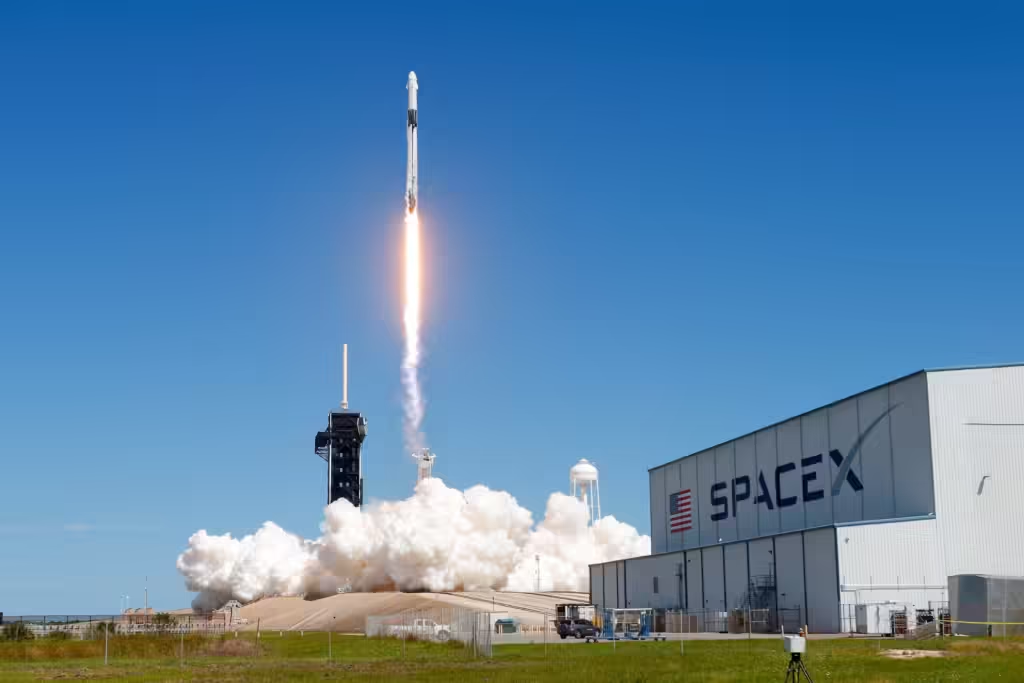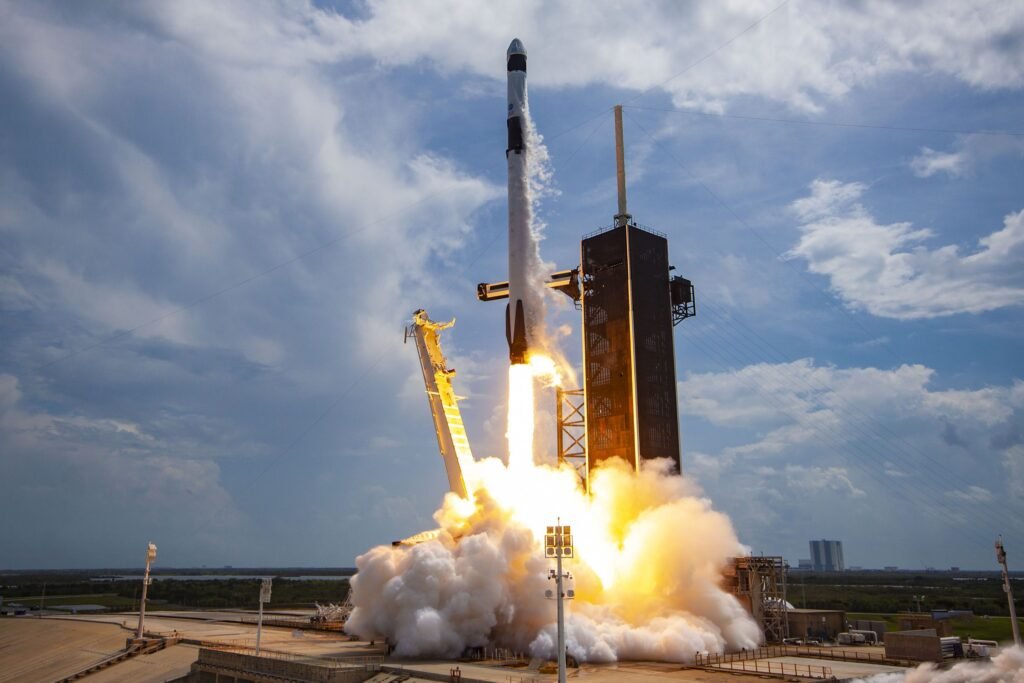How fast do spacex rockets go? SpaceX rockets achieve speeds of approximately 7.5 kilometers per second (about 27,000 kilometers per hour) during their ascent to orbit.
SpaceX, a pioneer in private space exploration, has revolutionized the aerospace industry with its advanced rocket technology. One of the most frequently asked questions about SpaceX rockets is: How fast do they go? Understanding the speed of these rockets requires a detailed look at their various stages, missions, and technological innovations.
How fast do spacex rockets go? Introduction to SpaceX Rocket Speeds
SpaceX rockets are designed to achieve high velocities to overcome Earth‘s gravitational pull and reach orbit. The speed of a SpaceX rocket varies depending on several factors, including the type of rocket, its payload, and its mission profile. Let’s delve into the specifics of each phase of a SpaceX rocket’s journey. Let’s break down the journey of a SpaceX rocket:

- Liftoff: The rocket ignites its engines and lifts off from the launch pad. During this phase, it accelerates rapidly to overcome Earth’s gravity.
- Ascent: As the rocket ascends, it continues to accelerate. The specific speed depends on the rocket model and mission. For example:
- Falcon 9: Reaches speeds of approximately 7.5 kilometers per second (about 27,000 kilometers per hour) during ascent.
- Falcon Heavy: Achieves similar speeds but with greater payload capacity.
- Staging: Most rockets have multiple stages. The lower stage (first stage) provides initial thrust, while the upper stage (second stage) continues the journey. After the first stage burns out, it separates (staging), and the second stage takes over.
- Orbit Insertion: The second stage carries the payload (such as satellites or crewed spacecraft) to its intended orbit. It reaches the desired velocity to maintain a stable orbit around Earth.
- Payload Deployment: Once in orbit, the payload separates from the second stage and begins its mission (e.g., communication, Earth observation, or scientific research).
SpaceX rockets achieve high speeds during ascent, allowing them to deliver payloads to space efficiently.
1.1 The Significance of Rocket Speed

Rocket speed is crucial for successful missions, whether for launching satellites, resupplying the International Space Station (ISS), or transporting astronauts. Achieving the necessary speeds ensures that rockets can enter orbit, complete their missions, and return safely.
2. Phases of SpaceX Rocket Speeds
The speed of a SpaceX rocket changes throughout its flight. Here, we will explore the key phases from launch to orbit.
2.1 Liftoff and Initial Ascent
During liftoff, SpaceX rockets experience rapid acceleration. The Falcon 9, for example, reaches a speed of 1,000 meters per second (m/s) within the first few minutes. This initial ascent is critical for escaping the dense lower atmosphere.
2.2 Max Q (Maximum Dynamic Pressure)
At a certain point in the ascent, rockets encounter Max Q, where aerodynamic stress on the vehicle is at its peak. During this phase, the Falcon 9 maintains a speed of approximately 1,500 m/s. Managing Max Q is essential for ensuring structural integrity. Max Q (short for maximum dynamic pressure) is a critical phase during a rocket’s ascent. Here’s the breakdown:
- What is Max Q?: It occurs when the rocket is at a specific altitude and velocity, typically around 1,500 meters per second (m/s) for the Falcon 9. At this point, the aerodynamic forces (air pressure) on the vehicle are at their maximum.
- Importance: Managing Max Q is crucial because excessive stress during this phase could lead to structural failure. Engineers design rockets to withstand this pressure by optimizing their shape, materials, and flight trajectory.
- Mitigation: To reduce stress, rockets often adjust their flight path, throttle engines, or use aerodynamic features (such as fairings) to minimize the impact of air resistance.
Successfully navigating Max Q ensures the rocket’s integrity and paves the way for a safe ascent to space.
2.3 Stage Separation and Second Stage Ignition
Once the first stage completes its burn and separates, the second stage ignites. The Falcon 9’s second stage accelerates the rocket to even higher speeds, reaching up to 7,800 m/s. This stage is crucial for achieving orbit. Let’s delve into the fascinating world of stage separation and second stage ignition in rocket launches.

When a rocket embarks on its journey to space, it does so in multiple stages. Each stage has a specific purpose, and as the rocket ascends, it sheds these stages to become more efficient. Here’s how it works:
- First Stage: The initial stage provides the primary thrust during liftoff. It burns its engines and propellant to propel the rocket upward. As it nears the edge of Earth’s atmosphere, it reaches a point called Max Q (maximum dynamic pressure). At this moment, aerodynamic stress is at its peak due to air resistance. To reduce this stress, the rocket adjusts its trajectory and throttles its engines.
- Stage Separation: Once the first stage has expended its fuel, it separates from the rocket. Explosive bolts or other mechanisms release it, allowing the next stage to take over. This separation is crucial for several reasons:
- Weight Reduction: Shedding the empty first stage reduces the overall weight, making the rocket more efficient.
- Optimal Trajectory: The second stage can now operate in a more favorable trajectory without the drag from the first stage.
- Second Stage Ignition: The second stage ignites its engines. Unlike the first stage, which primarily focuses on overcoming Earth’s gravity, the second stage aims to achieve the necessary velocity for orbital insertion. It carries the payload (such as satellites or crewed spacecraft) to its intended orbit.
Importance:
- Efficiency: Staging allows rockets to discard spent components, improving efficiency as the mission progresses.
- Payload Delivery: The second stage ensures precise delivery of payloads to their designated orbits.
- Multi-Stage Rockets: Most rockets have additional stages (e.g., Falcon 9 has two stages, while Falcon Heavy has three). Each stage contributes to the overall mission.
Challenges:
- Timing: Proper timing for stage separation is critical. Too early, and the rocket won’t reach the desired altitude; too late, and the first stage could collide with the second stage.
- Structural Integrity: Engineers must design stages to withstand the forces during separation.
Stage separation and second stage ignition are pivotal moments in a rocket’s journey, enabling it to reach space and fulfill its mission.
2.4 Orbital Insertion

For missions to Low Earth Orbit (LEO), such as delivering cargo to the ISS, SpaceX rockets must reach a speed of about 7.8 kilometers per second (km/s) or 28,000 kilometers per hour (km/h). Achieving this velocity allows the rocket to stay in orbit around the Earth.
2.5 Geostationary Transfer Orbit (GTO) and Beyond
For missions requiring higher orbits, such as Geostationary Transfer Orbit (GTO), rockets must achieve even greater speeds. The Falcon 9, for instance, can reach speeds of up to 10 km/s or 36,000 km/h to place satellites in GTO. This speed is essential for positioning satellites in a fixed position relative to the Earth.
3. Specific SpaceX Rockets and Their Speeds
SpaceX has developed several rocket models, each with unique speed capabilities. Here, we will focus on the Falcon 9, Falcon Heavy, and the upcoming Starship.
3.1 Falcon 9

The Falcon 9 is SpaceX’s workhorse, used for a variety of missions. Its two-stage design allows it to reach remarkable speeds. During a typical LEO mission, the Falcon 9 can achieve speeds up to 7.8 km/s. For GTO missions, it can accelerate to 10 km/s.
3.2 Falcon Heavy
The Falcon Heavy, consisting of three Falcon 9 cores, is the most powerful operational rocket in the world. It can achieve even higher speeds due to its increased thrust. For LEO missions, the Falcon Heavy can reach speeds similar to the Falcon 9, but for more demanding missions, it can exceed 11 km/s.

3.3 Starship

Starship, SpaceX’s next-generation rocket, is designed for deep space missions, including trips to Mars. While still in development, it is projected that Starship will achieve speeds necessary for interplanetary travel, potentially exceeding 12 km/s for its missions.
4. Factors Influencing Rocket Speed
Several factors influence the speed of SpaceX rockets. Understanding these factors is crucial for comprehending the variations in their velocities.
4.1 Payload Weight

Heavier payloads require more thrust, affecting the rocket’s acceleration and maximum speed. SpaceX rockets are designed to balance payload weight and fuel efficiency to optimize speed.
4.2 Mission Profile
The intended mission profile, whether to LEO, GTO, or beyond, dictates the required speed. Missions to higher orbits or interplanetary destinations demand greater velocities.
4.3 Atmospheric Conditions
Atmospheric conditions, including air density and weather, can impact a rocket’s ascent and speed. SpaceX carefully monitors these conditions to ensure optimal performance during launch. Let’s explore how atmospheric conditions influence rocket launches, with a focus on SpaceX’s meticulous approach to optimizing performance.
The Role of Atmospheric Conditions in Rocket Launches
- Air Density and Drag:
- As a rocket ascends through Earth’s atmosphere, it encounters varying air density. Thicker air at lower altitudes creates more drag, resisting the rocket’s upward motion.
- SpaceX engineers consider this drag during the design phase. Streamlined shapes and fairings help minimize air resistance.
- Max Q (Maximum Dynamic Pressure):
- Max Q is a critical point during ascent. It occurs when the rocket faces the highest aerodynamic stress due to air pressure.
- Managing Max Q is essential. Too much stress could damage the vehicle, while too little could compromise trajectory.
- Weather Conditions:
- Wind shear, turbulence, and lightning pose risks. SpaceX monitors weather patterns meticulously.
- Launch windows are chosen to avoid thunderstorms, high winds, and other adverse conditions.
- Temperature and Propellant Behavior:
- Cold temperatures affect propellant viscosity and combustion efficiency. SpaceX pre-chills propellants to optimize performance.
- Thermal protection systems shield rockets during ascent and reentry.
SpaceX’s Approach:
- Real-Time Monitoring:
- SpaceX uses ground-based sensors, radar, and weather balloons to track atmospheric conditions.
- Data on wind speed, direction, temperature, and humidity guide launch decisions.
- Dynamic Adjustments:
- During ascent, Falcon 9’s engines can throttle up or down based on real-time data.
- If winds exceed safe limits, the launch can be postponed or adjusted.
- Abort Systems:
- Crewed missions have escape systems. If conditions deteriorate, the Crew Dragon capsule can separate from the rocket.
- This ensures astronaut safety even during a launch anomaly.
- Trajectory Optimization:
- SpaceX calculates optimal trajectories considering atmospheric drag and gravitational forces.
- Adjustments mid-flight ensure efficient use of propellant.
SpaceX’s commitment to understanding and adapting to atmospheric conditions ensures safe and successful launches. By combining cutting-edge technology with real-time monitoring, they navigate Earth’s dynamic environment to reach the stars.
4.4 Rocket Technology
Advancements in rocket technology, such as improved engines and lightweight materials, contribute to higher speeds. SpaceX’s continuous innovation plays a significant role in enhancing rocket performance.
5. Achievements and Records
SpaceX has set numerous records for rocket speeds and mission accomplishments. Highlighting these achievements underscores the company’s capabilities.
5.1 First Reusable Rocket
SpaceX’s Falcon 9 was the first orbital rocket to successfully land and be reused. This innovation not only reduces costs but also demonstrates the rocket’s reliable speed and performance.

5.2 Most Powerful Operational Rocket
The Falcon Heavy holds the record for the most powerful operational rocket, capable of delivering the heaviest payloads at impressive speeds, reaffirming SpaceX’s leadership in rocket technology.
5.3 Starship’s Potential
Starship aims to be the fastest and most powerful rocket ever built. With its ambitious goal of enabling human missions to Mars, Starship represents the future of high-speed space travel.
Understanding how fast SpaceX rockets go involves examining the various phases of their missions, the specific rocket models, and the technological innovations that drive their performance. From the initial liftoff to reaching orbit and beyond, SpaceX rockets achieve remarkable speeds that enable a wide range of missions. As SpaceX continues to innovate and push the boundaries of space travel, the speeds of its rockets will undoubtedly continue to captivate and inspire.

